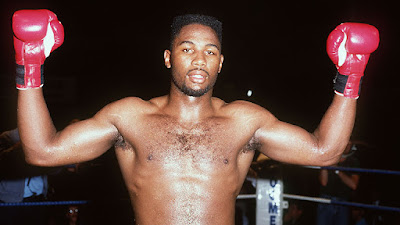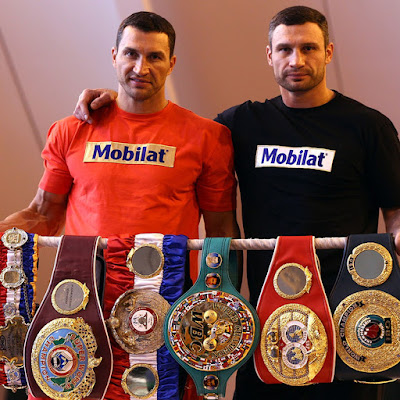Lennox Lewis Part One: Olympic Champion
In December 2019 I was on a family vacation in Ocho Rios, Jamaica. We visited Mystic Mountain, about five minutes from Dunn's River Falls (also highly recommended). On our ascent through the rainforest scenery on the SkyExplorer to take us to the famous Bobsled ride, I wasn't expecting to be greeted by a room full of sports memorabilia.
Obviously, the Jamaican Bobsled team dominated the room, but I was instantly drawn to the massive information board on Lennox Lewis and seeing smaller articles on Mike McCallum, Simon Brown and Glen Johnson, giving me the inspiration for The Pride of Jamaica posts.
Lennox Claudius Lewis was born in West Ham, England on 02nd September 1965 to Jamaican parents. His mother agonised over whether to terminate the pregnancy when she found out the man she loved was already married to a woman in Montego Bay. Fortunately for the boxing world, Violet decided against a termination. "I was desperate. But the moment I held baby Lennox in my arms I knew I had made the right decision."
In 1977, aged twelve, he moved to Kitchener, Ontario, Canada with his mother and attended the Cameron Heights Collegiate Institute, where he discovered his passion for sports, playing football, Canadian football and basketball. In the 1982/83 school year he helped the school's AAA basketball team win the Ontario provincial championship.
In 1978 he took up boxing, staying undefeated in his first three years, until he faced the sixteen-year-old Donovan Ruddock in the Ontario Canada Junior Championships. In May 1982 he dropped another decision in the same tournament, only to come back in 1983 as a Super-heavyweight gold medallist at the Junior World Championships in Santo Domingo, Dominican Republic.
The following year he won gold at the Canadian Amateur Championships and represented his adoptive country in the Los Angeles Olympics, losing to eventual champion Tyrell Biggs. He stormed back to success in 1985, becoming the Canadian Super-heavyweight champion once more and coming runner-up at the World Cup Championships.
He once again reigned supreme at the 1986 Canadian Amateur Championships and won gold at the Commonwealth Games held in Edinburgh, Scotland. He also reached the semi-finals of the TSC Tournament in Berlin, losing to the Russian Valeriy Abadzhyan and forfeiting the third-place bout to Ladislav Husarik.
He returned to winning ways in 1987, once again at the Canadian Amateur Championships and losing out in the final of the Pan-American Games on a four-one decision to the Cuban Jorge Luis Gonzalez. He picked up gold at the North American Championships, gaining revenge over Gonzalez. Lewis was then subjected to a disputed decision in the quarter-finals of the Amateur World Cup.
In 1988 he continued his dominance in the Canadian Amateur Championships and picked up a silver medal in the Intercup tournament held in West Germany. Lewis then won the Canadian Cup before representing Canada at the Seoul Olympics.
Lewis was in devastating form, stopping Chrispine Odera in the second and Ulli Kaden in the first before gaining a Walk Over victory against Janusz Zarenkiewicz in the semi-final. His gold medal match was against fellow decorated amateur Riddick Bowe.
Both men threw some wild haymakers in the opening round but it was Lewis who found his range in the second, forcing a standing eight count. After landing another heavy right, the referee issued another standing count. This time however, instead of allowing the action to continue, he sent Bowe back to his corner, meaning Lewis was now the Olympic super-heavyweight champion and the boxing world was his oyster.
Thankfully for the British fans, Lewis, who could have represented Canada and Jamaica, elected to sign his professional contract with Frank Maloney (now Kellie Maloney) under the flag of the Union Jack. Unfortunately for Lewis, his Canadian accent made it a hard slog to find acceptance by the British public.
Lewis turned pro on 27th June 1989 at the Royal Albert Hall, London, against Al Malcolm. Both men looked to land some heavy blows and Malcolm, who didn't taste the canvas regularly, found himself on the floor after taking a left hook in the opener. He survived to hear the bell, but an innocuous left put Malcolm down for the count after only 19 seconds of the second round.
Lewis won his next four with a disqualification of Melvin Epps stopping his kayo run, before travelling back to Canada in December 1989 to take on the American Greg Gorrell. Though Gorrell, a southpaw, had a decent record of 21-7 (15 KO's), every time he faced decent opposition he came up second best. Everett Martin (six-round decision), Anaclet Wamba (first-round TKO) and Seamus McDonagh (second-round TKO) had all bested him. The American managed to extend Lewis into the fifth round, before succumbing to a technical knockout defeat, as Lewis improved to 6-0.
Lewis kicked off 1990 by facing Liverpudlian Noel Quarless, who boasted seven first-round wins in a 19-11 (11 KO's) resume, including ending the career of former world champion John Tate in March 1988. Quarless was expected to give the Olympic champion a good test and started in a determined manner, keeping a tight defence as he fired his dangerous rights to Lewis' head. The novice probed his opponent with long jabs as he negated the potential danger.
Lewis opened up in the second round and Quarless tried to match his less experienced opponent, only to find himself shaken up and on the floor. Up at seven, he tried to nullify the onslaught by getting on the inside, but Lewis wasn't to be denied and pushed him off and fired in another attack. The Liverpudlian was forced to the ropes before visiting the canvas again, staying there to be counted out by the third man in the ring, Roy Francis.
The American Calvin Jones was up next and the pair faced each other at Gateshead Leisure Centre in March 1990, on the undercard to Glenn McCrory losing his IBF cruiserweight crown to Jeff Lampley in the third round. Jones had a 13-4 (8 KO's) ledger, but looking closer at this record, he had been in with some top fighters.
Jones turned pro in November 1987 against ex-WBA heavyweight champion John Tate (31-2 with 22 KOs) and was on an eleven-fight unbeaten streak since losing his second fight to Wesley Watson in January 1988. In September 1989 he dropped to 12-3 after retiring in the eighth round against another former WBA champion, James 'Bonecrusher' Smith. In his next contest he faced Tony Tucker, the ex IBF champion, who knocked Jones out in the fifth.
Jones had a first-round victory on 10th March 1990 in Bristol, Tennessee against Dino Homsey and twelve days later only lasted a round with Lewis, who improved to 8-0. Lewis was next in the ring against Mike Simuwelu, getting massive exposure on the undercard to Michael Watson's WBA middleweight title challenge to Jamaican great Mike McCallum.
Simuwelu, hailing from Zambia, had a decent record of 18-2-1, with seventeen early. Lewis had little trouble, stopping his opponent with a right high on the head followed by a left to the jaw, with only 58 seconds on the clock.
In June 1990 Lewis faced his first former world champion, Osvald (Ossie) Ocasio. The Puerto Rican debuted in February 1976, winning thirteen in a row, getting him a shot at Larry Holmes' WBC heavyweight belt in March 1979, losing by a seventh-round TKO.
In April 1980 he scored a draw with future WBA heavyweight champion Michael Dokes, only to be put down three times by Dokes, suffering a first-round TKO two months later. Ocasio lost for the third time in March 1981, before dropping down to cruiserweight to become the inaugural WBA champion with a fifteen-round split decision over the South African Robbie Williams in February 1982.
Ocasio made three successful defences, losing the crown in his fourth defence to Piet Crous at the end of 1984 via a fifteen-round unanimous decision. The former champ didn't fight again until March 1986 with a ten-round decision over Narcisco Maldonado and a points win against ex-WBA cruiserweight champion Dwight Muhammad Qawi in May 1987, setting up a challenge to WBA and IBF cruiserweight king Evander Holyfield that August.
The champion improved to 16-0 with an eleventh-round technical knockout. In March 1988 he inflicted the second defeat on heavyweight Pierre Cotzer, losing the rematch eight months later. Ocasio then took Ray Mercer (11-0), Tyrell Biggs (16-3) and Bruce Seldon (12-0) the distance, before facing Lewis at the Royal Albert Hall.
Lewis put in a raw performance and needed to work on developing his jab. Despite his lack of experience, he did some good work on the inside, notably ripping in some good uppercuts and showing a good chin. Had Ocasio been less durable then the body shots he was taking would have dropped him. Lewis completed the eight-round distance with loads to spare, apart from receiving a lukewarm reception from the crowd.
The Olympic super-heavyweight champion then travelled back to Canada to take on the American Mike Acey, who had a record of 11-4-1 with all his wins coming inside the distance. Riddick Bowe stopped Acey in the first round back in October 1989 and Lewis ended matters in the second to go 13-0 with eleven stoppages.
The unlikely European heavyweight champion, Jean-Maurice Chanet, put his title on the line against the unbeaten Lewis. Chanet, a French Gypsy, started his paid career in April 1985 and by the time he faced EBU champion Derek Williams, he had a modest record of 22-10 (8 KO's). Williams started brightly, shaking and cutting the Frenchman in the opening round. However, the champion went into a patch of lethargy and Chanet grabbed his opportunity, winning the crown with a unanimous decision. Williams also alleged his poor showing was down to being drugged and promised to redeem himself in the rematch.
Chanet won another unanimous decision in a dour affair, which would be remembered more for a brawl erupting in Williams' corner. The view had been obscured by the challenger's brothers who had congregated near the fighter's post. The fighting was so bad that the final round was postponed for ten minutes so the police could restore order. Williams needed a police escort back to his dressing room and hotel.
Chanet brought his EBU belt to Crystal Palace's National Sports Centre to face Lennox Lewis on 31st October 1990. Lewis used his long left lead to push back the crude Frenchman. The iron-jawed champion was cut between the eyes within the first minute and walked onto some thunderous rights.
The challenger had the advantages in height, weight and age, but when he looked to overwhelm him, Chanet would bravely battle back. By round six the cut was beginning to impair the champion's vision and Swiss referee Franz Marti awarded the contest to Lewis after 16 seconds of round six.
There was some controversy at the end as accusations were made that the Frenchman had used some substance on his body to give him an unfair advantage, which he had to remove all traces of. His cornermen also had a tube of what appeared to be coagulate confiscated by the BBBofC inspector. However, Lewis had dominated the contest on his way to winning his first professional championship and the EBU belt came with a top ten world ranking, which put him on course to become the first British-born boxer to win the world heavyweight championship since Bob Fitzsimmons in 1897.
Lea
Boxing Books are available on Amazon, Kobo, Apple Books, Smash Words, Google Play, Barnes & Noble, and most other digital stores: https://linktr.ee/leroy_fight_writer







Comments
Post a Comment